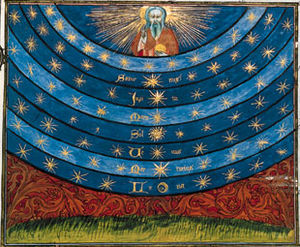
Back مستوى نجمي Arabic Астрал планĕ CV Plano astral Spanish Plan astral French Astralni svijet Croatian Աստրալի հարթություն Armenian Piano astrale Italian Астрал Kazakh Astrale vlak Dutch Plano espiritual Portuguese

The astral plane, also called the astral realm or the astral world, is a plane of existence postulated by classical, medieval, oriental, and esoteric philosophies and mystery religions.[1] It is the world of the celestial spheres, crossed by the soul in its astral body on the way to being born and after death, and is generally believed to be populated by angels, spirits or other immaterial beings.[2] In the late 19th and early 20th century the term was popularised by Theosophy and neo-Rosicrucianism.
Another view holds that the astral plane or world, rather than being some kind of boundary area crossed by the soul, is the entirety of spirit existence or spirit worlds to which those who die on Earth go, and where they live out their non-physical lives. It is understood that all consciousness resides in the astral plane.[3] Some writers conflate this realm with heaven or paradise or union with God itself, and others do not. Paramahansa Yogananda wrote in Autobiography of a Yogi (1946), "The astral universe ... is hundreds of times larger than the material universe ... [with] many astral planets, teeming with astral beings."
The "World of Al-Ghaib" and the "World of Barzakh" are related concepts in Islam (also the concept of 'âlam al-mithâl "imaginal world" in Sufism). In Judaism, it is known as the "World of Yetzirah", according to Lurianic Kabbalah.
- ^ G. R. S. Mead, The Doctrine of the Subtle Body in Western Tradition, Watkins 1919.
- ^ Plato, The Republic, trans. Desmond Lee, Harmondsworth.
- ^ Robinson, Matte (2016). The Astral H.D. United States of America: Bloomsbury. pp. 15–47. ISBN 9781628924176.
© MMXXIII Rich X Search. We shall prevail. All rights reserved. Rich X Search